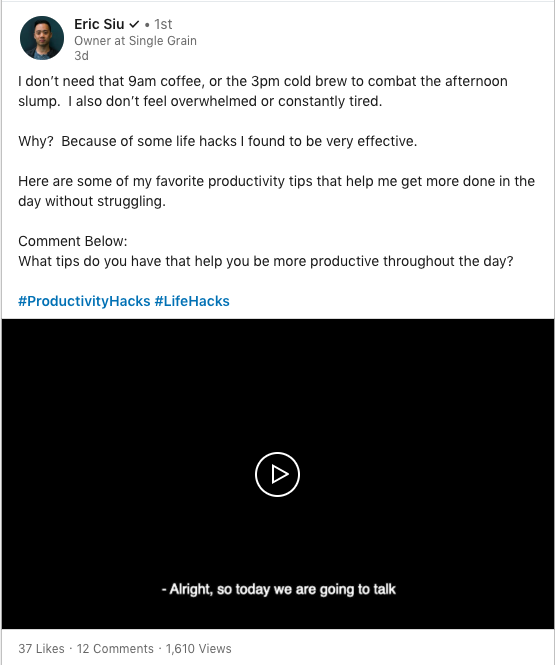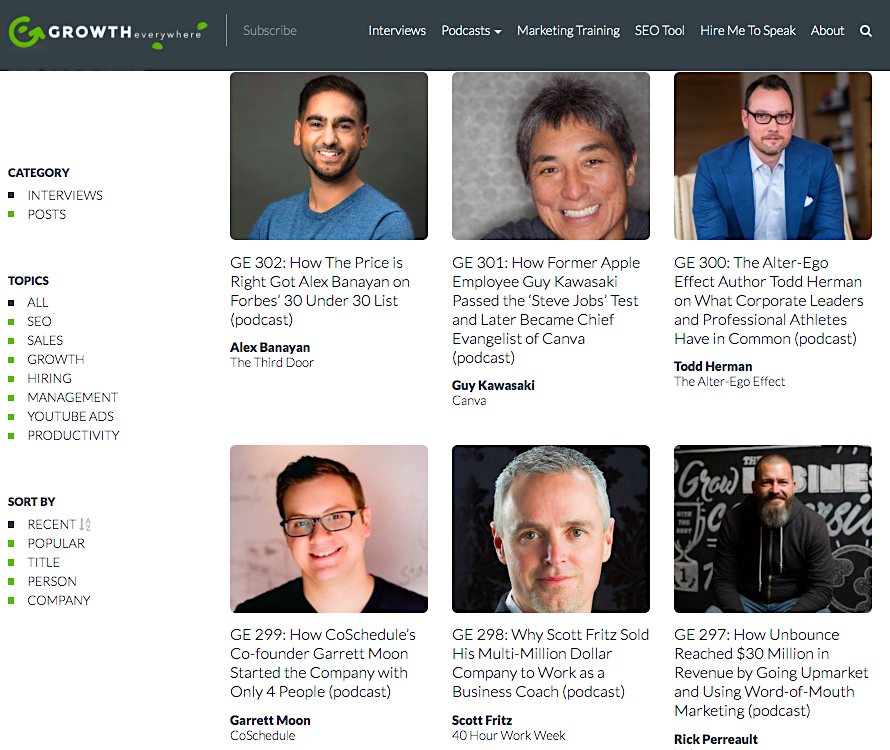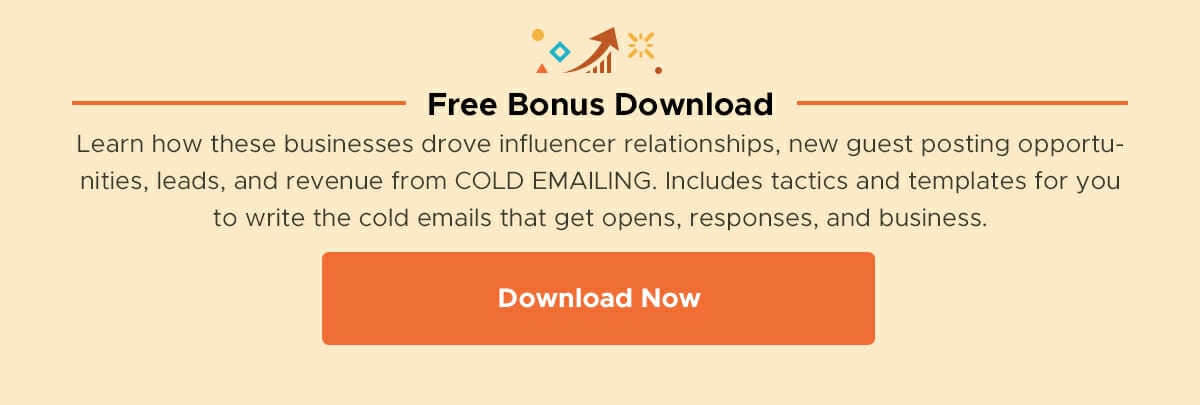The Customer Acquisition Playbook: Email & In-Person Outreach
I’m frequently asked what my most effective client acquisition channels are for Single Grain. The best client acquisition channels for investment may not be what you expect.
While our content marketing nets us the most leads, our second-best client acquisition channel doesn’t have anything to do with technology or data – it’s word-of-mouth and referrals.
My two podcasts, Marketing School and Growth Everywhere, are the third-most effective place to source clients, but, as you’ll see later in the article, I consider them an offline, relationship-building channel.
Those relationships could be from the private marketing dinners I put together, the masterminds I’m part of, or relationships I’ve developed with former clients.
Let me outline what my best customer acquisition agency tactics are.
TABLE OF CONTENTS:
- Comparing the ROI for Conferences and Private Dinners
- Offline and Online Marketing Should Work Together, not Compete
- How Do I Even Start?
- Should You Make a Sales Pitch, Cold Call or Cold Email?
- Want to Really Stand Out? Send a Personalized Gift
- How Do You Increase Social Media Engagement?
- How Can I Get SaaS CEOs as Clients?
- How Can I Use an Event to Build Relationships?
- What Is the Best Way to Gain Clients? Build Strong Relationships
Comparing the ROI for Conferences and Private Dinners
Measuring the return on investment (ROI) of these relationships can seem challenging, but it can be done. After doing an ROI analysis of all the money that my team and I spent going to conferences over the last few years, I found that our eventual ROI was about 20x. (The ROI had to be calculated over some years as customers may take a while to commit fully, especially with high-ticket items like agency services).
I also completed an ROI analysis of the private dinners I hold for entrepreneurs and marketers. After considering everything, they had a return on investment of about 20-21x. Surprisingly, even though the conferences were “sales” events and dinners were a “social” event, the ROI for both events was almost precisely the same.
Now, I don’t want you to get the wrong idea. The point isn’t to go out and start hosting dinners for would-be clients or take talking up new leads to a new level. I want to stress that developing relationships can lead to just as many new clients as “traditional” online methods.
Dive Deeper: Why All Marketers Should Go to Conference After-Parties
Offline and Online Marketing Should Work Together, not Compete
We get about 70% of our clients from online marketing efforts. These are often more direct contacts. Unlike online marketing, offline marketing can meander a bit before it yields the lead you hope to have.
For example, say I’m at a dinner party and share contact details with someone I think I’d work well with. Instead of sending them an email after the event and asking them to purchase Single Grain services, I use what I know about them and suggest that they come on my podcast episode, or that we produce a YouTube interview together. They could also guest blog for us, or we can chat about a partner webinar.
Any of these are a win/win. With the podcast, for example, we both get exposure to each others’ audience and spheres of influence. The value-add for both of us extends far beyond selling to one customer.
And, you never know, they might just end up working with you directly, too.
Recommended Reading: How to Use Engagement Marketing to Acquire More Customers
How Do I Even Start?
If you have no testimonials or social proof and are just starting out, you have one precious commodity on your side: your time. In the beginning, I offered to work for free in exchange for getting a client. Doing so helped build positive connections, receive priceless testimonials, gain goodwill in the field, and added to my portfolio of experience.
If I Work for Free, How Do I Continue the Relationship?
Just like offering an audit or another type of “introductory service,” you can turn a “will work for testimonial” relationship into a paid contract.
All you need to do is offer a way for the relationship to continue. If they liked your work, chances are they’ll agree to a continuation. If not, it’s not the end of the world, because you’ve built your portfolio and received a testimonial that will get you even more work. If you get a “yes” to continuing 50% of the time, you’re making substantial progress
The Best Places to Connect with People
There is no one channel that’s going to be best for everyone. A particular tactic or strategy might work for most people, but it is impossible to state that, for example, Twitter is the best relationship-building channel of them all.
Again, when you’re just starting, remember that you have the commodity of time. Do everything you can to build relationships. Be on every channel, personally reach out to people (in a customized manner, see below) in your industry, and attend networking events.
The connections that you build when you have the time to develop them will be among the strongest you will ever make. You will reach a time when you wish that you could still dedicate as much attention to networking as you were able to in the beginning.
When you have figured out what works best for your personality and your potential client base, double down on it. Focus on creating more avenues where you can utilize those strengths. It takes time to learn which methods and channels work for you and your specific products or services. It also takes brutal honesty to be able to say, “hey, I need to work on my networking skills” or “wow, my emails are too general.”
And about that….
Dive Deeper:
- How to Use Personalization to Increase the Impact of Email Marketing
- Top 10 Best Email Marketing Services
Don’t Send the Same Email to 1,000 People
One of the biggest no-nos when building new relationships is to send the same canned emails to as many people as possible. You shouldn’t do that in the beginning…and you shouldn’t do it after you have had some success, either.
People talk. It is not good for business to have people think that they received something personal, only to find out that they were one of 500 people to receive the same message.
Pay attention to every potential client or customer you have connected with – stalk their LinkedIn and other social channels. Find blogs that they’ve written or podcasts that they either produced or were interviewed on.
Personalize every interaction at least a little bit. It isn’t that hard to write a couple of sentences about a recent blog post that someone recently published, or a podcast that you heard. This shows that you’re paying attention while also building rapport.
As Alex Berman states, there are a few simple steps to begin with when writing cold emails:
- Pick a neutral subject line
- Be specific about the recipient’s company
- Start with a compliment
- State something the recipient knows is true
- Offer a solution
I’ll go into more detail on these points down below.
You could also try using conversational bots to get started, but since they are such a big deal right now, you’d still be falling into the trap of sounding like everyone else sending an email. Nothing beats some good old-fashioned research and personalization.
Should You Make a Sales Pitch, Cold Call or Cold Email?
In the early days, I sent emails telling the person or company that I was trying to connect with that I had found an error on their website. It took about 20 minutes per email, but it paid off. Not everyone responded to those emails, but I had already provided value to those who did.
Think about what value you can add to people’s businesses or lives. Maybe you read a blog post with a dead link and your article or product can replace it. Or perhaps you can offer to write blog posts for the company. The prospect of introducing people to your contacts may be tantalizing to someone who is looking to make new connections.
If you remain consistent, you’ll start to generate your luck. Always find a way to give something to your client before you ask for anything in return. Everyone knows when they are being sold to, but they don’t always expect help if they haven’t asked for it. This proactive approach makes a positive first impression and may even make it easier for you to develop a stronger pitch or just a way to break the ice.
It is possible that you may need to try each of these tactics to figure out which one is most effective for your purposes. With that being said, here are a few more things to think about when it comes to the options mentioned above.
Sales Pitch
The days of people being able to sit through a long sales pitch are long gone. Nobody’s got time for that. Your sales pitch needs to be short and sweet, while also covering everything your contact needs to know. It can be tricky to balance efficient with informational. Here is a possible framework to start:
- State the problem that you can solve
- Have a strong, jargon-free, concise statement of value
- Highlight what makes you different from others offering the same service
- Share clear examples of your success
- Relate customer examples (the more personal, the better)
- Close with a question that encourages further conversation
Dive Deeper: Why Every Business Should Implement Sales Enablement
Cold Calling
In a time when everything seems to be text messages and quick reads, cold calling seems like it should be a thing of the past. But what’s the one thing that I have repeated over and over? Make. It. Personal. And it doesn’t get much more personal than talking to a live person.
Here are some benefits of cold calling:
- It establishes direct contact. Emails can be deleted and sales pitches can be ignored. Phone calls tend to be picked up regardless, especially from an office phone (yes, people still use those!).
- You can learn more about your contact. Instead of a static email or pitch, you can ask a few questions or get verbal confirmation about any problems they may be having.
- Smile and dial. Yes, even on the phone. You can’t underestimate how much a smile can change the tone of your voice.
- That personalized touch. Once again, having a conversation with someone is a great way to establish rapport and make connections. It works in real life and can work on the phone as well.
Cold Emails
As mentioned above, a strong subject line can make or break the email. I like to write an engaging question in the subject line and keep the email short – the shorter, the better. It builds curiosity up front and makes it easy for people to scan to get to the point. Remember, it’s still about the connection.
Emails now come up with a preview line as well as the subject. You have to be smart about this. If your preview line is an introduction, people will immediately see that they don’t know you and your email will probably end up in the trash. Pull them in with something personalized that will catch their attention.
If that preview is written correctly, you’ll get them to open the email, and that is when you hit them with what you have to offer. But even at this point, keep it personal to them. Don’t go on and on about how amazing you are; cut to the core of your message and make them want to contact you to find out more.
Dive Deeper: The 10-Minute Guide to Cold E-mail Campaigns for Marketers
Want to Really Stand Out? Send a Personalized Gift
Once you’ve done your research and you know more about what your prospects may like, you can send them customized gifts or swag.
For example, I’ve got a knife that a friend of mine sent me. It’s a Cutco knife, personalized with my name on it. If I actually cooked, this would be something I would see every day and remember who gave it to me. But I use this example all the time, so I guess it sticks in my memory anyway. 🙂
The same type of personalization can go on a sports jersey from a team that they follow on social media. You could also go practical and send a better keyboard or a new tech gadget. Just ensure that your prospect will use it.
And do not – I repeat, do NOT – put your logo on it. Branded swag is cool if you’re at a conference, but I would never recommend it for an individual gift.
How Do You Increase Social Media Engagement?
If you engage with people, they tend to respond. You can’t just wait for people to come to you, you have to go to them.
For instance, if someone is talking about not being able to sleep enough, I’ll share my tips for optimizing my sleep. If someone is looking for a VP of Sales who is experienced in SaaS, I’ll DM them and let them know that I can make an intro to an experienced friend. You get the idea.
It’s like a conversation at a networking event: don’t just stand in the corner; interact. Ask questions. Reply to every comment and answer every question that you can. The more active you are, the more momentum you can build.
Ask questions intended to get responses instead of just sharing your accomplishments and content. Shares, likes, views, comments…the algorithms love all of those, and you’ll start showing up more often.
I used to post my podcast to LinkedIn with a quick description of the topic. Now I’ll post longer pieces that ask questions I am sincerely interested in getting answers to. Going back to the individual attention again, people love to share their value, experience, opinion, or even just relate to the issue I raise.

Even if you have no engagement right now, you can start not just by posting your own content, but by liking, sharing, retweeting and answering others’ content. Much like connecting with people in real life, you’ll render goodwill. Giving, without expecting to ‘cash in’ on it, builds organic relationships that, paradoxically to traditional sales, is more effective.
Learn More: The Beginner’s Guide to Crafting a Highly Effective Social Media Strategy in 2019
How Can I Get SaaS CEOs as Clients?
Find a way to get face-time with a CEO, founder or executive without making a hard sell. Remember that these people are busy and flooded with sales pitches all day long – they don’t want another canned email asking them to buy a product or service.
I get to know SaaS CEOs – and eventually, I’ve sold my services or products to them – by asking them to be on the Growth Everywhere podcast:

It shows that I respect them individually and want to get to know their story. I get facetime and I get to have an extended conversation with them. They want to build their brand, and I offer a way for them to do so – another example of a win/win situation.
Dinners and masterminds are other ways to get SaaS CEOs together. I find exciting marketers, founders and CMOs in the SaaS space, and then I invite ten of them to a nice restaurant. They get to meet interesting people who they can potentially do business with. And we all get a little bit more facetime with each other.
Learn More:
- Why Joining Multiple Mastermind Groups Will 10X Your Business
- 10 SaaS Business Lessons from $1B+ Unicorns (like Slack, Twilio, Lyft)
- 12 Best SaaS Marketing Tactics for Business Growth
How Can I Use an Event to Build Relationships?
Say you’re at a conference. You want to think outside of the box and come up with a way to get a group of people together so you can talk to and get to know them. First, find something you have in common.
For example, if you’re into fitness, find a group of people who are also into fitness and set up a time to take a fitness class together, like a SoulCycle class early in the morning of the second day of the conference. This gives you an experience that you have in common, something you can refer back to in the future, while also setting you up as a leader and organizer.
Now, obviously, setting up a fitness class isn’t the same as hosting an event, like the dinners I mentioned earlier. This is more about building on a common interest in a social way. Once again, it’s that personalization factor. But find ways to make yourself memorable as a helpful and friendly partner.
If there are a lot of out-of-towners at the conference, and you know the area well, suggest a “locals only” type place for dinner. Or, if people have mentioned that they like whiskey, find a whiskey bar to go hang out at in the evening. These are all things that your potential clients would be doing anyway; you’re just being proactive about getting them together to do it.
Learn More: Attention Marketing: 10 Tips to Acquire More Customers
What Is the Best Way to Gain Clients? Build Strong Relationships
Strong relationships are the foundation of long-term business. Personally, my business receives a 21x ROI from our relationship-building events. It might not be straightforward, but it works. Our offline efforts enrich our online marketing efforts, which is where we get most of our business.
To build new relationships, you need to stand out by paying individual attention to people. This kind of customized experience will get you results, and the more consistent you are, the more successful you will be.
Use your time to your advantage by offering free work for testimonials, reading up on your best prospects and sending them customized emails or offering to guest post for their blog. Reach out to anyone who might be interested in your services. Tell them exactly why they need you, then offer something for free to entice them.
By giving value, you’ll receive value. It may take some hard work and patience, but building that social capital will always engender goodwill, and you can never have too much of that.






